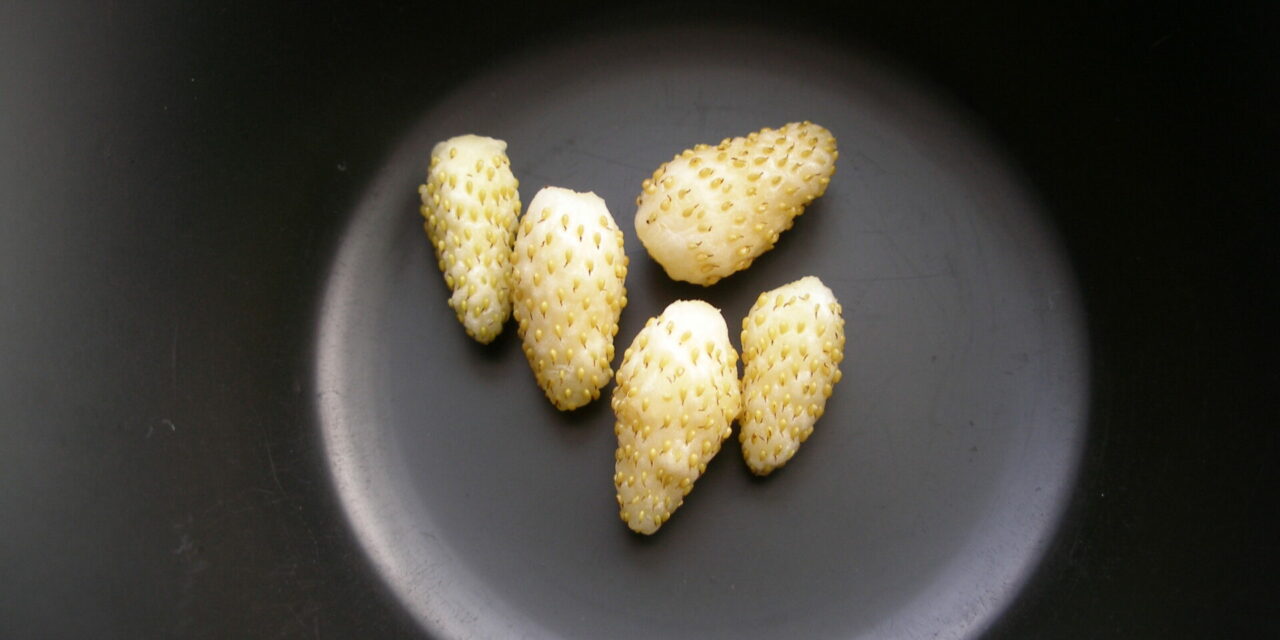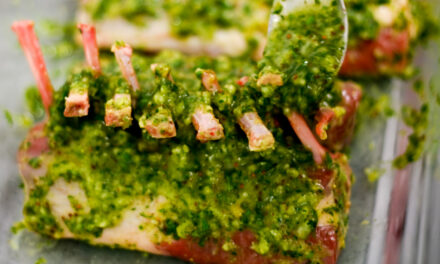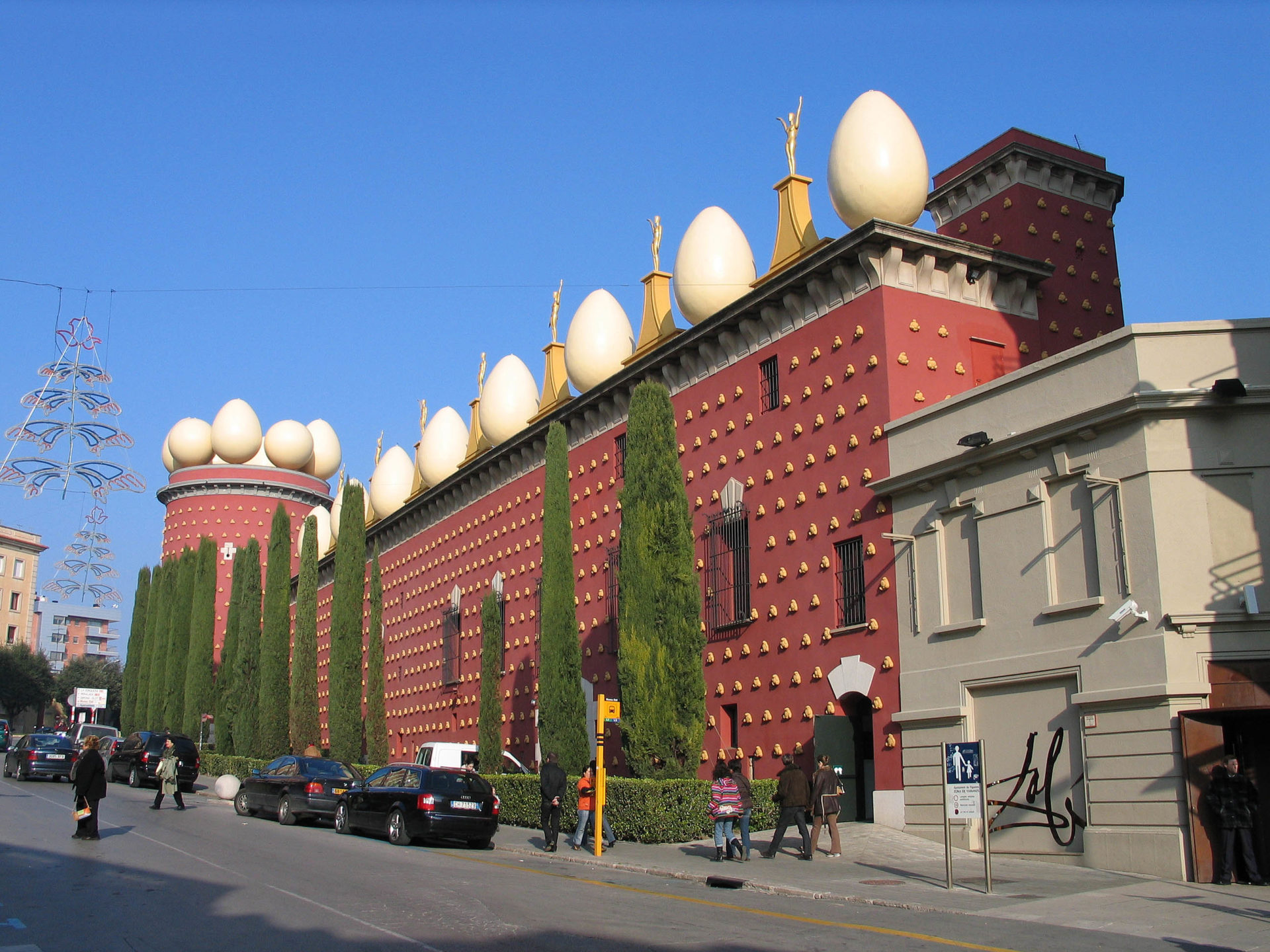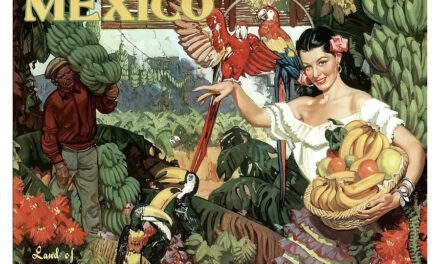White Strawberries, by Thomas Quine, CC BY 2.0, via Wikimedia Commons.jpg
Strawberry Fields Forever
Once upon a time, in a place far, far away, up and down the Pacific coastal Cordillera de Nahuelbuta, there were strawberries everywhere. In the moderate mountain sunshine, you could smell the warm and sweet perfume on the breeze lifting up from the ocean below. The berries were much larger than the tiny wild strawberries known in North America and Europe. They were big as walnuts, and they were pale pink or creamy white in colour.
The frutilla blanca, or white strawberry, was domesticated around 1300 AD by the Mapuche people of Chile. It was a sacred plant, essential to culinary, spiritual and medicinal aspects of their lives. The Mapuche ate them fresh and dried. They used them to combat digestive problems. And because the weukufu, or devil, hated everything that was sweet, they were used to ward off evil. The frutilla blanca was also an important ingredient in chicha, a fermented fruit cocktail, long before the region became a producer of amazing grape wines.
Today the white strawberry is in danger. Berry central is a town called Puren, where annual white strawberry festivals feature beauty pageants, music, baking contests, and clery, which might be described as a strawberry sangria. But outside the city limits, the fruit is nearly forgotten. Garden variety strawberries are plentiful through Chile, but the indigenous frutilla blanca is barely known in its own country. Just a handful of growers in a couple of towns still farm these ancient beautiful berries.

Dupont Book of Hours, workshop of the master of Echevinage de Rouen (France) c. 1480
Europeans had long waxed poetic and romanticized the strawberry. It was the wild woodland strawberry that made its way into the marginalia of ornate illuminated manuscripts and into the books of hours, which were illustrated prayer or devotion books. There were even various Madonna and Strawberry paintings, associating the Virgin Mary with the berry. The sweet strawberry symbolized purity, beauty, and perfection. It also symbolized humility because it grew close to the ground.
Like most symbols, the meaning changed with context and culture, as well as possessing duality in its significance. The strawberry was associated with purity and Mary. But it could also represent erotic passion and temptation. The strawberry’s surreal and lustier side famously showed up in the puzzling painting of Hieronymus Bosch, where at least a dozen naked figures circle a giant berry. Such symbolism suggests warnings born of older interpretations: in ancient Rome, the strawberry signified a love of another kind, that of the Venus variety.
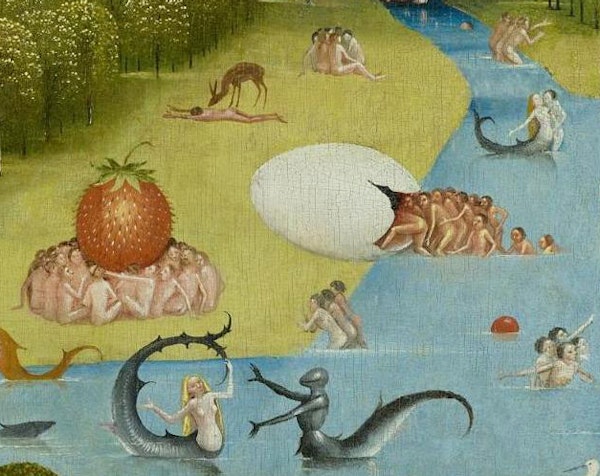
detail, Garden of Earthly Delights, by Hieronymus Bosch (Netherlands) c. 1490 to 1510
Whether virgin or Venus envy, the Europeans in Chile were smitten by the white berries. Noticing this fascination, the Mapuche used the frutilla blanca patches to lure the Spanish and ambush them. One 17th century captive of the Mapuche, Spanish soldier Francisco Núñez de Pineda y Bascuñán, wrote about the strawberries much later in El cautiverio feliz.
“…They brought me a plate of good size of fresh cultivated strawberries, and without exaggeration some were so large they could not be finished in two bites. They devote even more care to their strawberry beds than we give to vineyards because they dry great quantities of them for their chicha.”
The Spanish invaders were so enamoured with the white strawberries that they took them with them on their various expeditions, and so the frutilla blanca spread to Peru, Ecuador, and Colombia. Plants were also taken back to Europe. According to George Darrow in The Strawberry: History, Breeding, and Physiology, a French engineer and spy was sent to Chile in 1712. He returned home with five of the fragaria chiloensis berry plants. They did not bear any fruit in France, but the plants lived heartily on for decades. In the 1750s, wild mountain strawberries, or fragaria virginiana, were brought back from the “new world.” The plants hit it off with the Chilean beauties, and there we have it, the modern strawberry we all know and love was born.
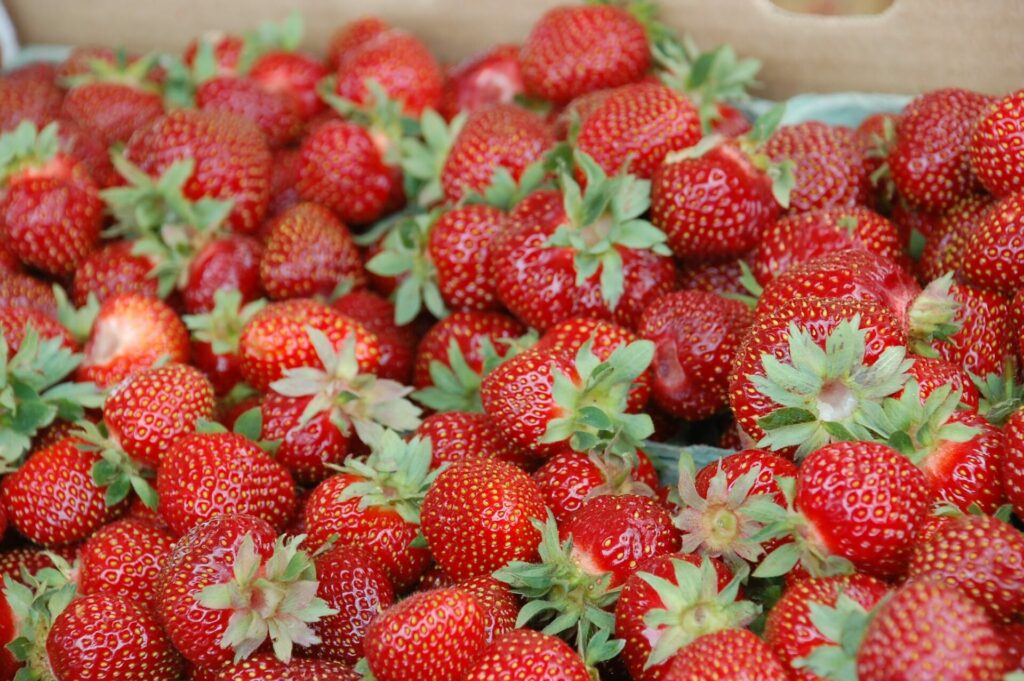
Fresh Ontario Strawberries at Wynn’s Farm, by Julep67 via Flickr CC BY-NC-ND 2.0 DEED
There are over 600 varieties of strawberries and around 100 different species. But far and away the most commonly grown and consumed kind is the fragaria ananassa, also known simply, as “strawberry.” As Ontario blooms into May and June, you’ll see all kinds of varieties of strawberries to pick, eat, and chop onto vanilla ice cream. Most of these varieties come from the white and mountain strawberry’s lineage.
The now-generic “garden variety” we call strawberry has taken over here, there, and everywhere. The modern strawberry has more or less devoured its white ancestor even at home in Chile. There are movements underway to save the frutilla blanca as part of Chile’s indigenous heritage, but only a couple dozen farmers still grow them on tiny, single acre plots. The modern strawberry, as well as massive tree planting initiatives for the lumber industry, has decimated the soils favoured by the original berry.
There are other white strawberry varieties out there. The white Jewel berry is one of Japan’s “luxury” fruits, which are kind of like designer fruits. They are not entirely natural, however, bred for paleness and grown with little sunlight, so that little of the red pigment anthocyanin is expressed. Less than ten percent of the Jewels turn out white, which is the explanation for the shocking price point of around $10 bucks per berry!
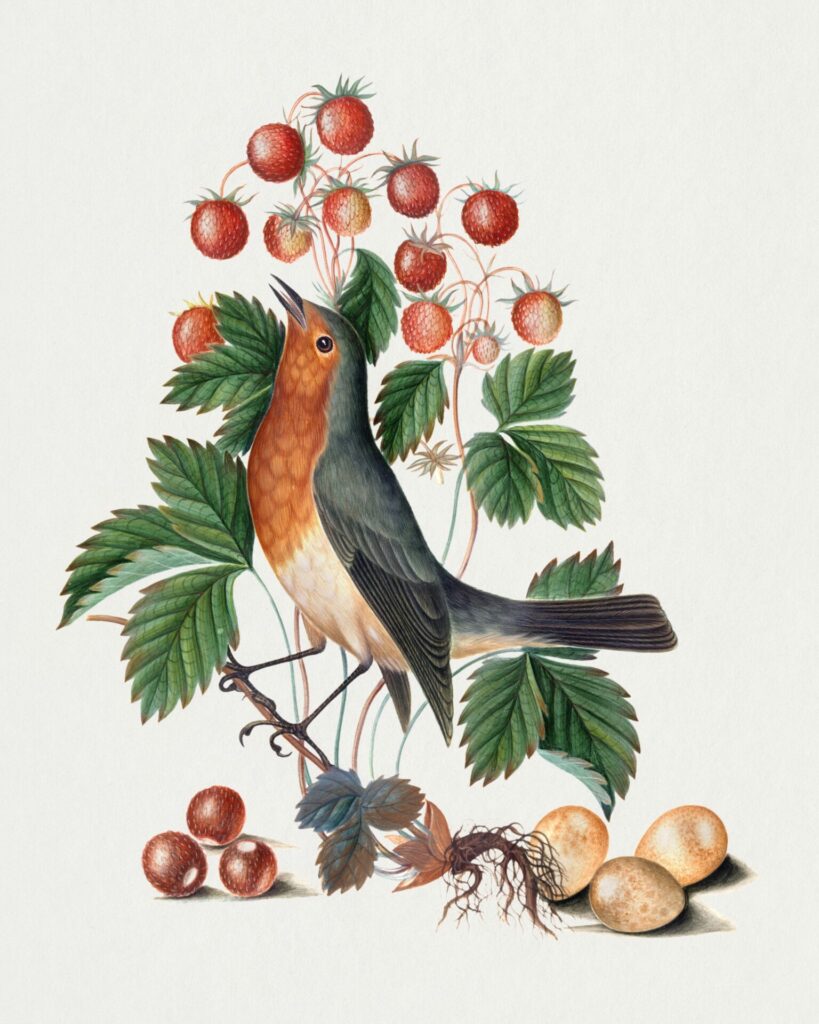
Robin and Wild Strawberries, by James Bolton (UK) 1768
At home in Canada, red modern berries abound. Those of us fortunate enough to live around the Niagara peninsula welcome late May and especially June because it is strawberry season. Although people consume imported berries, frozen berries, and berry jam galore year round, we all know that plump juicy strawberries picked the day before, or still warm from the sun, are the best jewels of nature. Sun-soaked strawberries with plenty of rain burst with fleeting flavour. Transporting them ripe turns them to mush, so import and export berries are still green when packed and never capture the heaven we have here at home. Ripe and ready berries are so delicious and fragrant that they perfume the air around them.
Ontario and Quebec grow more than two-thirds of Canada’s strawberries. Crop yield shifts dramatically, intimately dependent on sun and rain and at the mercy of a wide variety of scourges and pests. A Canadian average figure looks around 25 thousand tonnes annually. Production acreage has actually shrunken dramatically in recent years, but prices of the fruit have more than doubled in the past couple of decades, making the dollar value something like 125 million per year.
Canada is famous for our strawberries, but we aren’t even in the top ten for strawberry production. And neither is Chile! Not surprisingly, the position of top producer goes to China, with other three million, three hundred thousand tonnes. Our American neighbours are next, with just a third of that output, around a million tonnes. Egypt, Mexico, Turkey, Brazil, Poland, Morocco and others are on the top ten list. The whole world loves strawberries!
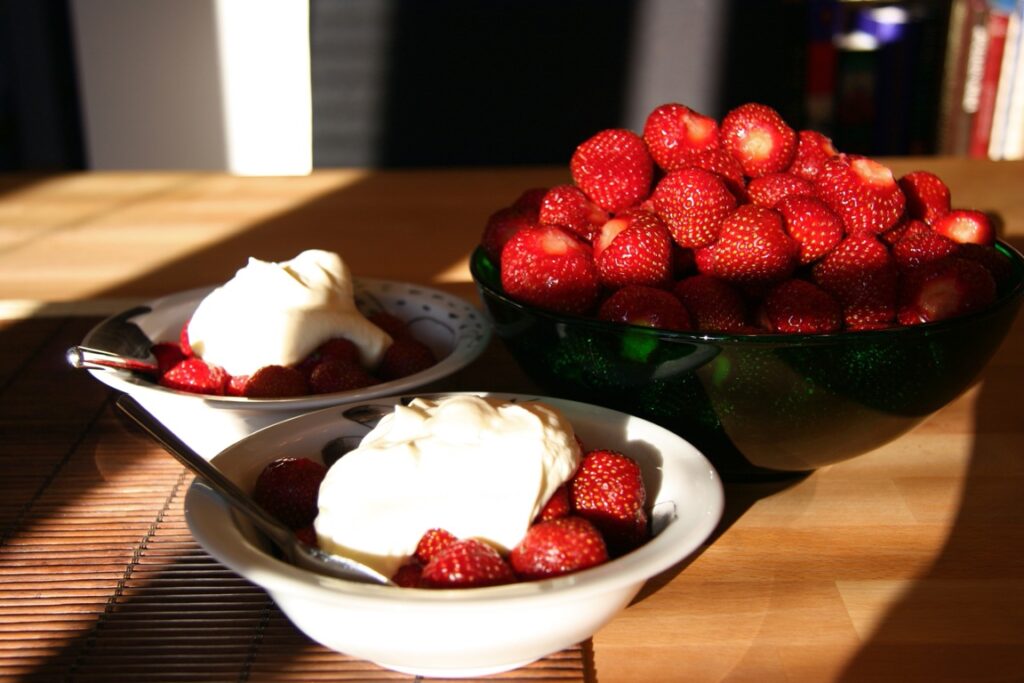
Strawberries and Cream, by :kallu via Flickr CC BY-SA 2.0 DEED
What could possibly be more delicious than sun-warm fruits, resplendent with sweetness and dew? Not much. But strawberries and cream is a simple and classic decadence that doubles your pleasure.
Tennis fans may be aware that strawberries and cream is the traditional treat at the annual Wimbledon championships in London, the oldest and most prestigious tennis tournament in the world. Since 1877, consuming a dessert of strawberries and cream is part of the thrill for the audience. The New York Times reported Audrey Snell, librarian of the Wimbledon Lawn Tennis Museum, explaining that the tradition is born from the fact that strawberries and tennis both signal the arrival of summer. Around 60 thousand pounds of berries are eaten with cream annually at Wimbledon.
Historians trace the marriage of strawberries to cream to around 1509, when Thomas Wolsey was preparing a lavish banquet for the court of King Henry the Eighth. Seasonal wild and woodland berries were the star of the ball.
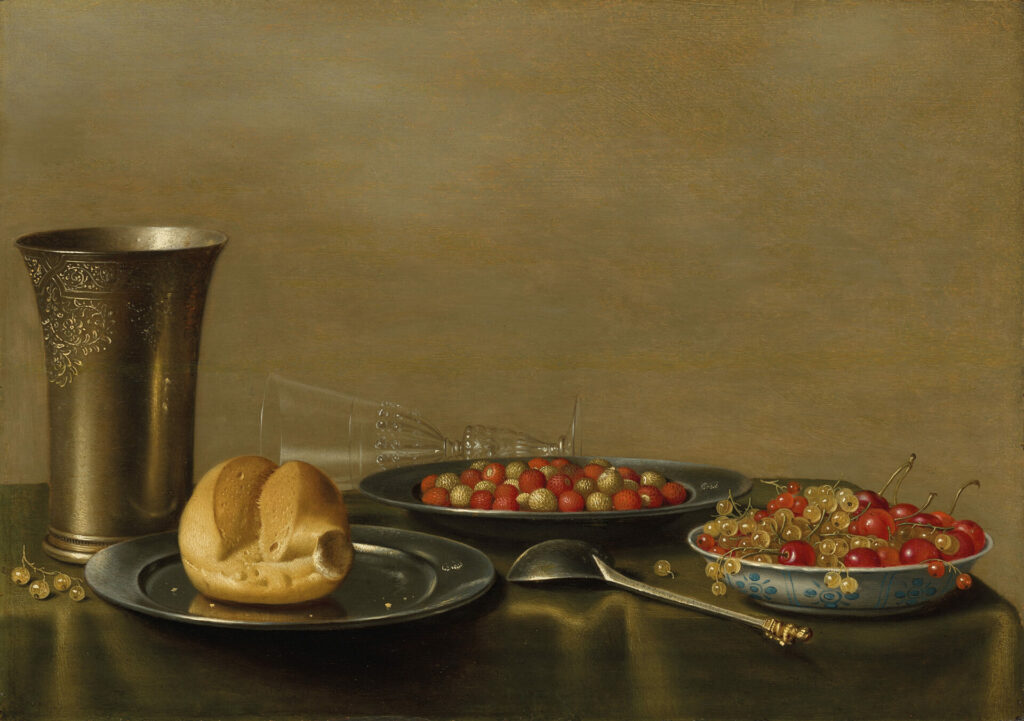
Strawberries in a Silver Dish, Cherries and White Currents in a Wanli Bowl, by Floris van Schooten (Netherlands) c. 1580
Arguably, strawberries and cream still wins out, centuries later, as the be all and end all of strawberry desserts. When it comes to strawberries, making things too complicated distracts from the fruit’s natural perfection. Eating strawberries with cream keeps the focus on the berry flavour. And while we still love the combo, the modern way to eat this classic is with ice cream. Everyone adores the simple abundance of vanilla ice cream heaped with slices of strawberries.
The other obvious match made in heaven is strawberries and chocolate. There are many variations on this theme, but simplicity is again key with our beloved berry. Dipping a fresh berry into warm chocolate for a chocolate-covered strawberry is the best version. Chopping fresh berries into a bowl of chocolate ice cream is also delicious.

Drop Dead Simple Strawberry Rhubarb Pie, by Sarah R. via Flickr CC BY-NC-ND 2.0 DEED
But we do stuff strawberries into every conceivable dessert. We love them fresh, but when there is an embarrassment of riches and a bumper crop, no one complains! The strawberry-rhubarb combo is beloved to anyone of Mennonite or Amish descent, whether pies or crumbles. Recipes for gooey strawberry truffles and cobblers abound. Of course, strawberry shortcake is legendary. Recipes for variants on this have been showing up in Europe and America since the 16th century. Strawberry mousse, strawberry pavlovas, strawberry cheesecake, strawberry waffles, and strawberry daquiris are just a few of the options.
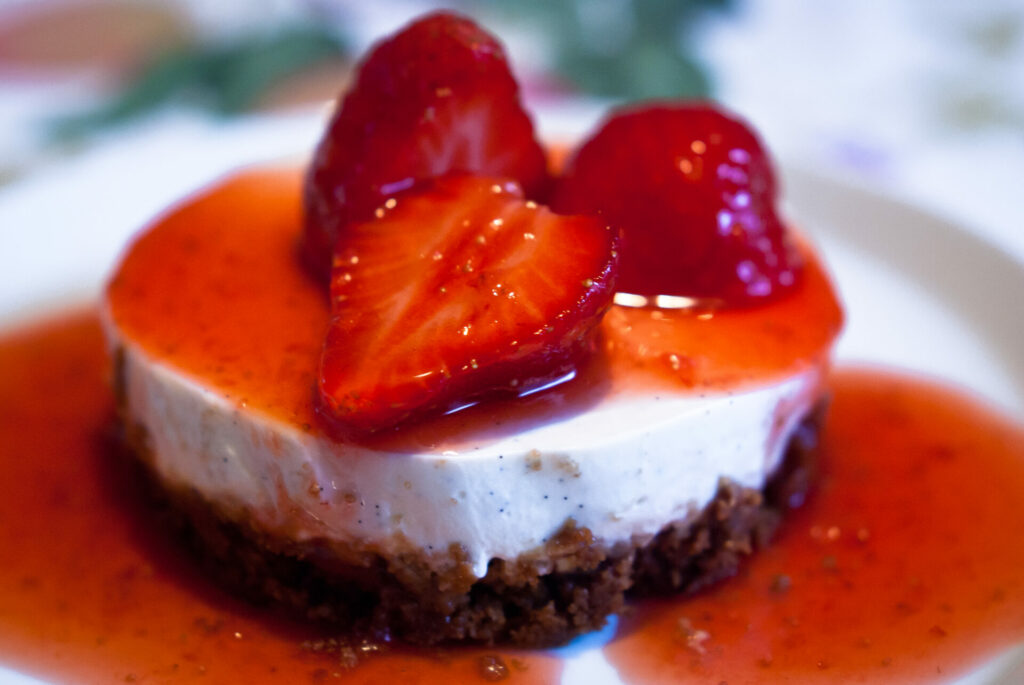
Strawberry Cheesecake by Stijn Nieuwendijk via Flickr CC BY-NC-ND 2.0 DEED
Strawberries are divine indeed for sweet tooth indulgences. But they do occasionally make their way into savoury recipes, adding a contrasting dash of sugar to salad, for example. Chopping a few fresh berries into spinach salads is an easy way to amp up the gourmet. Strawberries go particularly well with poppy seed or balsamic dressings, and with avocado or walnuts or pecans, or all of the above.
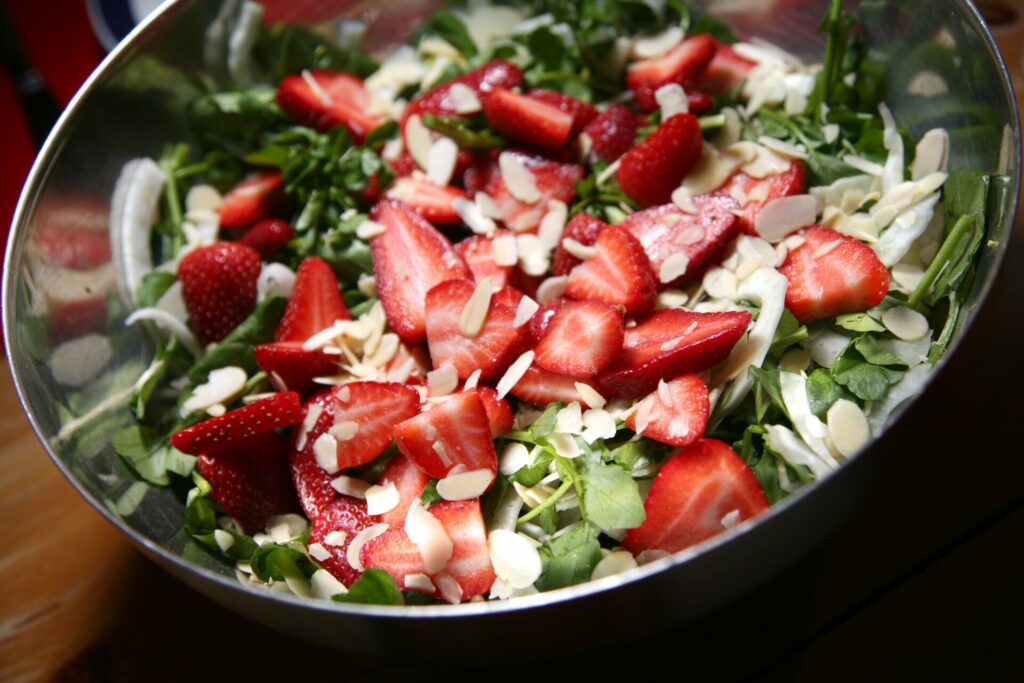
Strawberry Salad by Simon Law via Flickr CC BY-SA 2.0 DEED
A unique fusion strawberry sensation is found in the UK: strawberry curry. Sejal Sukhadwala explains over at Atlas Obscura’s gastro pages how fruit curries are quite popular in India. The best known is mango curry, but banana curry and others are widely prized recipes. In England, strawberries are a longstanding tradition. Indian cooking is classic in the UK, from both British colonialism in India and immigration from South East Asia. Strawberry curry was bound to happen!
Zupa truskawkowa, or strawberry soup, is something Polish folks are reclaiming from the bad memory file. Thin and clear broth, or a pureed slurry, it is served with egg noodles or any leftover pasta. The soup was served in institutions during the communist era as often as thin tomato soup, and though it left a sour taste in the mouth, now it is a matter of nostalgia and food bloggers are creating their own versions of it.
The strawberry soup history of Russia is robust. Everyone knows about borscht, or beet soup, which was also served both hot and cold, or both thick and thin. Russia also enjoyed cherry and strawberry and other fruit soups traditionally.
Mexico has a mouth-watering strawberry aguachile, which is a soup or a salsa or a juice, depending on your interpretation. It involves berries, onions, peppers, cilantro, chiles, and other herbs and spices.
Back in Chile, where the strawberry story began, strawberry borgona makes good use of berries as well as the abundance of grapes. Basically, wine is mixed with macerated berries, for an amazing and refreshing beverage.
Strawberry season is coming…and it will be gone before you know it. The cyclical nature of growing things is always bittersweet, and the harvests mark the years as they blaze past. Make the most of this year’s bounty by shopping local and feasting on strawberries and whipped cream.
**
“Do you remember the Shire, Mr. Frodo? It’ll be spring soon. And the orchards will be in blossom. And the birds will be nesting in the hazel thicket. And they’ll be sowing the summer barley in the lower fields… and eating the first of the strawberries with cream. Do you remember the taste of strawberries?”
J.R.R. Tolkien, The Return of the King
Lorette C. Luzajic
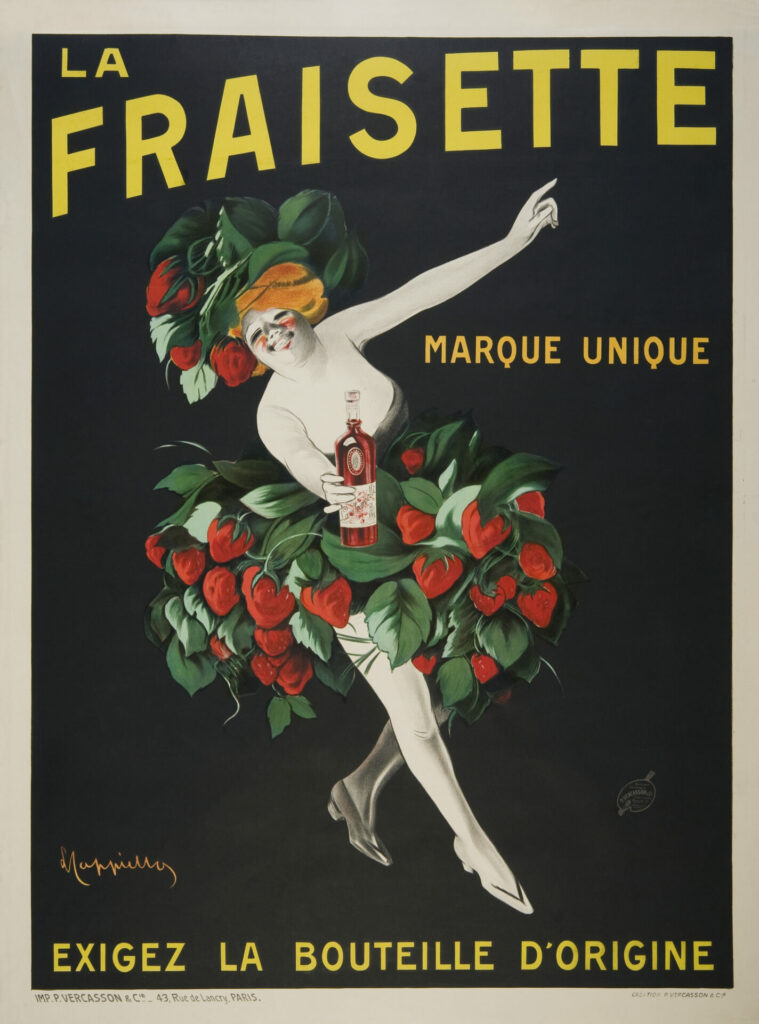
La Fraisette Strawberry Liqueur, by Leonetto Cappiello (France, b. Italy) 1909
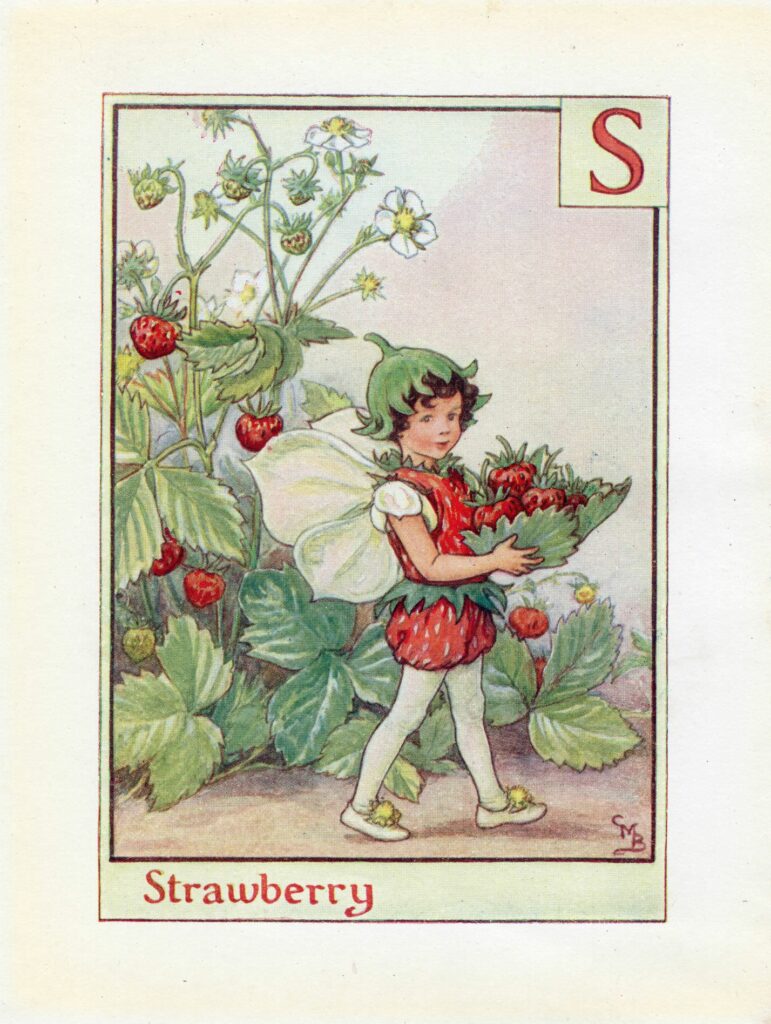
Strawberry, by Mary Cicely Barker (UK) 1940

